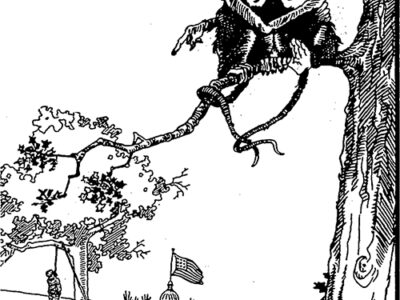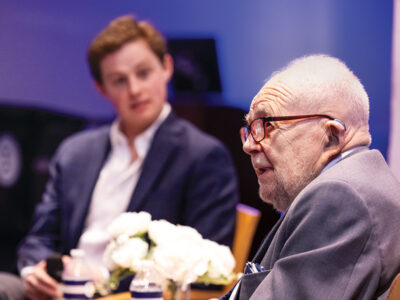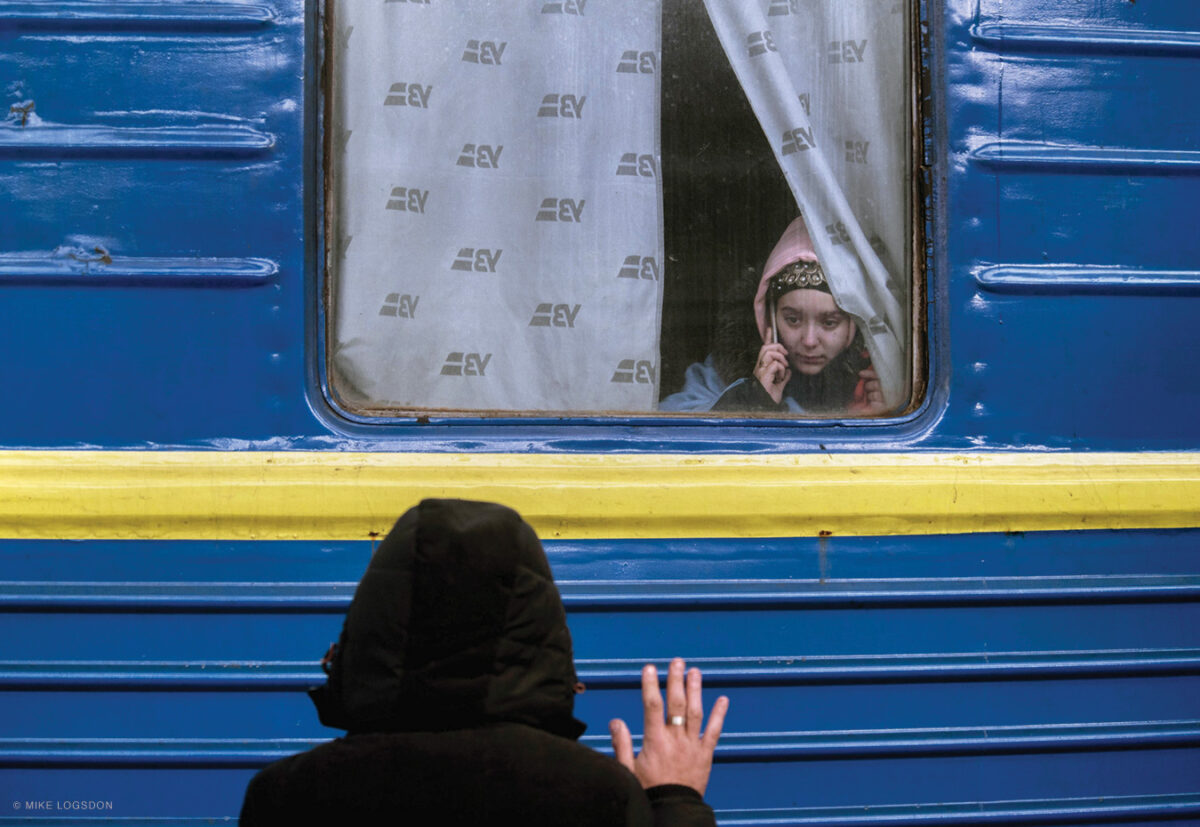
Penn faculty examine the conflict from multiple perspectives—sometimes clashing, sometimes meshing, and often thought-provoking.
By Trey Popp | Photography by Mike Logsdon C’03
In early March, Philadelphia-based photographer Mike Logsdon C’03 undertook a winding journey through Poland and western Ukraine to arrive in Kyiv. Inspired by his mother’s childhood experiences as a refugee in Australia and Morocco, he aimed to document the intimate stories of Ukrainians driven from their homes by the Russian invasion.
“It’s easy to forget when we hear that 3 million Ukrainians have fled the country and millions more are internally displaced that each of these men, women, and children have a story,” he said. “Where statistics can strip away the humanity of this crisis, hopefully images and names can restore it, to a small degree.” The images in these pages were taken during the first month of the conflict. For more, visit instagram.com/mike.logsdon.photo.
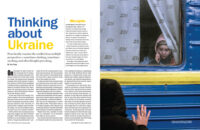
On December 21, 1991, 10 years before becoming the US ambassador to Russia, Alexander Vershbow watched the world order swing on a hinge. The setting was the inaugural meeting of the North Atlantic Cooperation Council, a NATO forum established to facilitate direct consultations with the alliance’s erstwhile Warsaw Pact adversaries. He reminisced about that day’s drama at a Perry World House colloquium in late January of 2022.
“At the end of that first meeting,” Vershbow recalled, “the Soviet ambassador announced that he had to take his name off the communique, because his country had just ceased to exist. And then, 10 minutes later, a telegram came from Yeltsin saying: I’m now the president of Russia, and I want to be a member of NATO.”
NATO archives and contemporaneous reporting suggest that Boris Yeltsin’s message—which framed Russian membership not as an immediate request but rather a “long-term political aim”—preceded the Soviet representative’s dramatic announcement. But three decades later, that moment of astonishing fluidity looms like a giant question mark about what might have been.
“So there may have been moments when we could have done more than we did,” Vershbow reflected, toward the end of a discussion devoted partly to Russian president Vladimir Putin’s objections to NATO’s eastward expansion in the 21st century.
“But it was the Russians themselves who decided that membership was less appropriate than a kind of special, unique strategic partnership,” continued Vershbow—who was the US ambassador to NATO from 1998 to 2001. “They didn’t want to be lumped together with Albania and Croatia and Slovenia. They felt that Russia deserved kind of a special arrangement.
“Maybe that was a mistake on their part,” he concluded. “Or we shouldn’t have taken no for an answer.”
As he spoke, Putin had amassed troops at Ukraine’s border but most observers were reading the buildup as a negotiating tactic. Yet while Vershbow felt the odds pointed to a “limited-scale” action combining cyber warfare, targeted infrastructure attacks, and political assassinations, he departed from then-current expert opinion on several counts.
“I personally worry that Putin, frustrated by his failure to break Ukraine’s will since 2014, may feel he has no choice but to deliver on his threats and impose a new Iron Curtain across Europe—regardless of the high price Russia will pay,” he said. That price would be “much more harmful to the Russian economy than what we did after [Russia’s annexation of Crimea in] 2014, when we were still hoping that we could find a diplomatic off-ramp that never appeared,” he continued—predicting that Germany would terminate the Nord Stream 2 gas pipeline (which at the time was still widely viewed by German business interests as an intolerable step) after being “worn down” by US pressure.
Yet there was scant reason to think it would matter. “Does this all add up to preventing Russia from attacking? Probably not,” said Vershbow. “That’s the sad reality: our leverage isn’t as substantial as we might wish. And for Putin this is an existential issue—because without Ukraine the Russian Empire will never be complete.”
In all his grim pessimism, Alexander Vershbow turned out to be someone worth listening to during his late-January visit to Penn’s campus. Four weeks later, Putin ordered the most sweeping military invasion seen in Europe since World War II.
By March 2, when Vershbow returned to the stage at Perry World House (where he is a distinguished visiting fellow this year), some two million Ukrainians, overwhelmingly women and children, had fled the country amid the onslaught. Yet their nation was simultaneously mounting a resistance that surpassed virtually all predictions.
To some degree, the first month of the war was horrendous precisely on account of the deadening familiarity it bore to any number of recent conflicts—from Putin’s bloody 1999–2000 siege of Grozny, to the US invasion of Iraq, to Moscow’s incursions into eastern Ukraine, the site of chronic fighting since 2014 [“With the Donbas Battalion,” Nov|Dec 2014].
But it was also a mess of scrambled expectations.
Putin’s decision to cross the brink amounted to “the greatest gamble of his career,” in the view of Russia historian Benjamin Nathans—“so much more reckless” than anything he had done before. Ukraine’s response showed just how profoundly that nation’s political reality had shifted since the 2014 “Revolution of Dignity,” according to Mitchell Orenstein, a professor of Russian and East European studies whose 2019 The Lands in Between: Russia vs. the West and the New Politics of Hybrid War examined some of the dynamics at play [“Essays,” May|Jun 2019]. In Germany, prime minister Olaf Scholz announced military commitments that had become virtually inconceivable among younger generations, noted Wharton finance professor Stephan Dieckmann, who as a West German teenager happened to begin his own 18-month mandatory military service soon after the Berlin Wall came down. In the US, Russia’s invasion exposed political dynamics both amply precedented—like attempts by fossil fuel interests to milk the crisis for policy advantages—and altogether novel—like the whiplash spectacle of certain Republicans struggling to adjust yesterday’s pro-Putin rhetoric for a moment dramatically less amenable to it.
On Penn’s campus discussions unfurled everywhere from Marc Flandreau’s course on the history of the international monetary system, to Arthur Waldron’s Strategy, Policy, & War, to departmental roundtable events. The perspectives on offer varied considerably. An open-minded undergrad seeking to make sense of what was going on might have traveled any number of paths. But it wouldn’t have taken long before one analysis was complicated by another.
So Vershbow’s March 2 return to Perry World House makes for a good launching point. Calling Putin’s rationale for invasion a “fabricated crisis,” he posited that “neither Ukraine nor NATO poses a security threat to Russia. What Putin fears is that if Ukraine succeeds in building a prosperous democratic state, it will set a dangerous example that could undermine the authoritarian Putin system in Russia itself.”
Which is one way to interpret it.
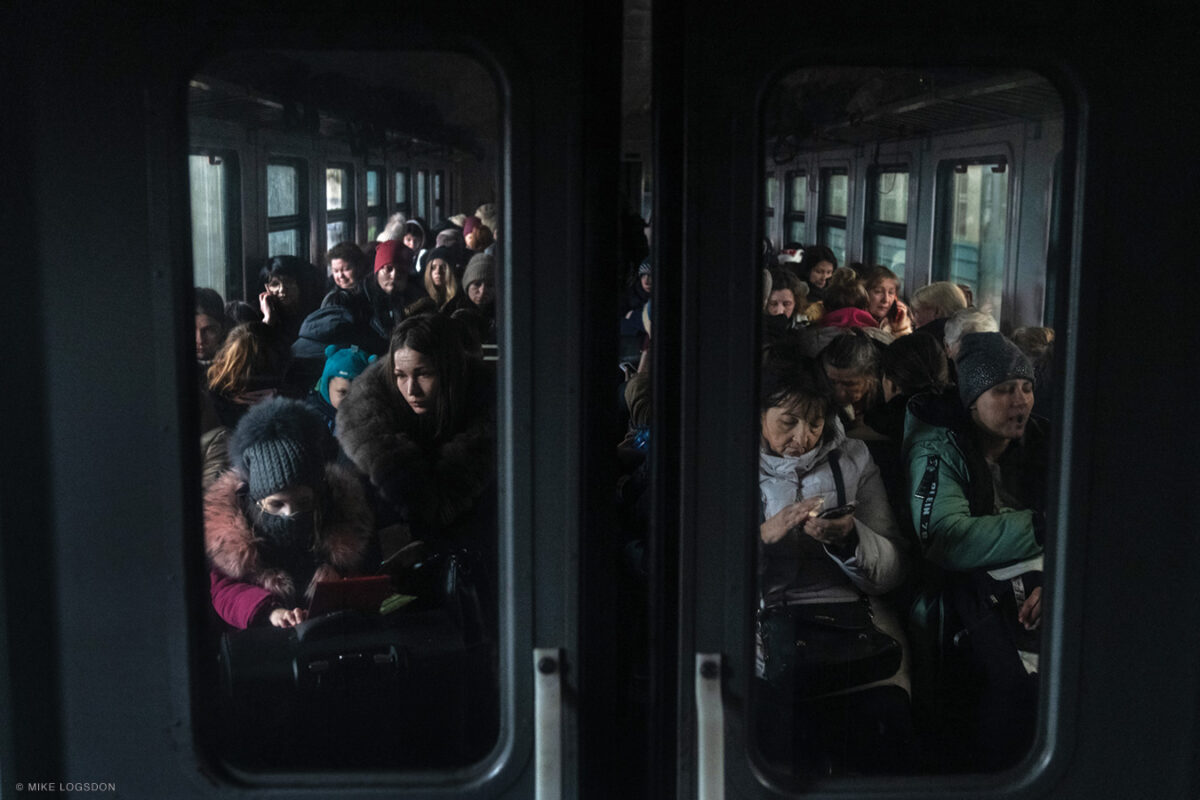
WHY? EXAMINING PUTIN’S MOTIVES
“To say that there’s no security threat doesn’t strike me as fully realistic,” said Benjamin Nathans, the Alan Charles Kors Endowed Term Associate Professor of History, in early March. “After all, what Putin is doing is in part imagining what Ukraine might become in a decade or two. And he is probably unwilling to take the risk that a Ukraine that’s peaceful today might one day want nuclear weapons, or might one day want to host an American military installation on its territory. So I don’t think it’s correct to say there’s no threat—or reason to perceive a threat.”
And even if Putin dramatically overexaggerated the nature of the threat to serve his own purposes—as Nathans thought—there were plenty of officials in the Kremlin who shared his outlook. “He couldn’t execute any of these plans if there weren’t lots and lots of people who were willing and able to go along.
“If we imagine that Putin is somehow magically subtracted from the equation, you could find people who want to do what he’s doing—you could find people who’d want to do far worse,” he said. “But you could also find a lot of people, including among the political elite around Putin, who would prefer a more cautious approach—who would prefer a version of Putin we thought we were getting to know 10 years ago, before the annexation of Crimea: a nationalist, for sure, someone pursuing Russia’s national interest, but doing so in a way that was cautious, and professional, and seeming to be engaging in the kind of risk-assessment and cost-benefit analysis that we would recognize from our own habits.”
But has Putin really changed his stripes? Or did viewing him as a calculating but ultimately flexible operator prior to the Crimea annexation depend on a kind of selective attention that discounted the seriousness of his complaints?
“I don’t think we’re dealing with a radical break,” said Nathans. “If you go back and look at Putin’s public statements, like at the 2007 security conference in Munich, he’s been remarkably consistent. This is a case study of why it’s important to listen to what authoritarian leaders say, and not to just dismiss it as ranting and raving.”
Perhaps no member of Penn’s faculty has listened as intently as political science professor Rudra Sil, who last appeared in these pages in an article titled “How to Think Like Vladimir Putin” [“Gazetteer,” May|Jun 2017]. In March, Sil observed that the Kremlin’s fixation on Ukraine and other post-Soviet states goes back to the dissolution of the USSR. Even as they were reminted as sovereign nations, places like Ukraine, Georgia, and Belarus retained transportation networks, energy infrastructure, and trading patterns that were woven into the fabric of the Russian economy. The Russian language was also widely spoken in some of these new nations, including Ukraine.
“So this was not an ordinary separation,” Sil said, observing that Moscow’s intention to hold sway over its new neighbors went back to the Yeltsin era. “It was his own foreign minister Andrei Kozyrev—who was one of the most Westernized foreign ministers—who had the idea that the ‘near abroad’ band of countries” would fall under Russia’s sphere of influence, into which NATO would not expand.
But Russia’s economic desperation in the early 1990s made the Kremlin’s geopolitical ambitions hard to sustain, from a Western perspective. “We just didn’t care, at the time, because Russia was not in any position to thump its chest,” said Sil.
By the middle of that decade, NATO expansion had become something approaching a passion project for President Bill Clinton, in Vershbow’s telling. “He felt that it was a question of historical justice to the countries that had been part of the Warsaw Pact and living behind the Iron Curtain,” Vershbow said. “So Clinton himself pushed this issue through disagreements within his own administration, and was instrumental in bringing other allies on board.”
The policy was that Russia itself could petition for NATO membership, but it played out in a way that stoked antagonism. Hungary, Poland, and the Czech Republic joined NATO in 1999, at the height of the US-led NATO bombing of rump Yugoslavia—which was undertaken without the UN’s approval, over Moscow’s objections, and led to the acceleration of Slobodan Milosevic’s ethnic cleansing campaign in Kosovo, which emerged in civic disarray.
“Yeltsin was furious” over the bombing campaign, which suggested that NATO’s ambitions went beyond mutual defense, said Sil. “It was a moment of total impotence for what was just eight years ago a superpower.” And it was the first domino in a cascade that saw seven additional former Eastern Bloc nations join NATO in the early 2000s, just as Putin was beginning his reign. The new NATO members gained security guarantees that seem especially invaluable now, but each one was perceived as a threat by the Kremlin.
The September 11 attacks opened a window of cooperation, as Putin provided substantial support for the US war in Afghanistan. But the full-scale invasion of Iraq—again without UN approval, and justified by dubious claims involving weapons of mass destruction that Secretary of Defense Colin Powell later characterized as “inaccurate and wrong, and in some cases deliberately misleading”—helped to slam it shut, along with what Sil characterized as “noises about other members of the former Soviet Union potentially becoming members of EU or NATO” and developments like President George W. Bush’s withdrawal from the Anti-Ballistic Missile Treaty.
“Those things all suggested that the security architecture of Europe, from Moscow’s point of view, was kind of falling apart,” Sil observed, pointing to Putin’s forceful critique of a US-dominated “unipolar” world order at the 2007 Munich Security Conference.
“So at that point there was no more dream of joining NATO,” he said. “It’s more about containing NATO”—a process that steadily approached a boiling point over the next 15 years, for reasons that, in Sil’s view, transcend Putin himself.
“I think it would be a mistake to think that we remove Putin and the problem goes away. Maybe the invasion goes away—you need someone with Putin’s personality, with his hubris, his impatience even, to pull that trigger,” he said. But Putin’s grievances reflect “an elite foreign policy perspective” within the Kremlin. “I think Lavrov, for example, the foreign minister, genuinely believes this as well … so there’s an establishment view there that I think is broader than Putin.”
Be that as it may, it begs the question of timing. Putin chose to invade Ukraine at a particular moment. Why did he act in late winter of 2022?
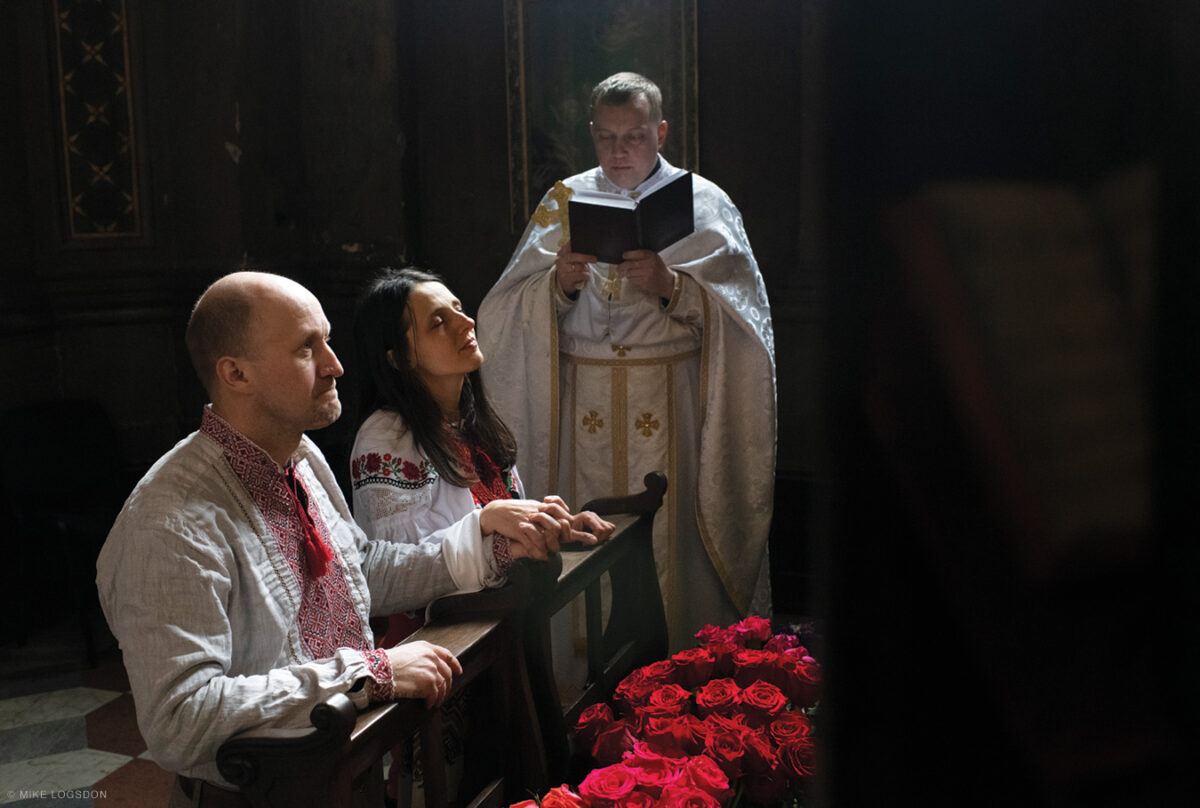
WHY NOW? ON PUTIN’S TIMING
Alexander Vershbow explained Putin’s timing as a function of his perception of fraying resolve and coordination among his US and European Union adversaries.
“I think he sees weakness in the US after the botched withdrawal from Afghanistan,” Vershbow said in late January. “He sees new, uncertain governments in places like Germany—with a coalition that is somewhat divided on how to deal with Russia. He sees French President Macron striking out in his own direction. These are potential friction points in the alliance that Putin would definitely try to exploit. So the challenge is first of all to convince him that we’re not as weak as he thinks we are.”
In January, Vershbow credited the Biden administration for corralling the key players into a “united front” that telegraphed a willingness to impose far steeper economic punishments than the feckless responses to Crimea and the Donbas. As later reported in the Wall Street Journal, the administration began accelerating this diplomatic campaign over the weekend of Thanksgiving 2021.
“I honestly thought that the huge military buildup was mainly meant to increase leverage for a diplomatic solution and that Putin wouldn’t actually pull the trigger,” Vershbow reflected in March. “The fact that there was a parade of Western diplomats paying court to Putin before this house all blew up was a sign that the strategy might actually have been working. But in the end deterrence wasn’t effective, and Putin rolled the dice.”
Vershbow chalked up that decision to mounting frustration—and fear—over Ukraine’s progression from Russian clientelism to civic liberalism. “The fact that this country is not only resisting Russian domination but actually having the nerve to succeed in establishing Western democratic institutions [that are] beginning to deal with corruption, makes it even harder for him to control,” Vershbow said. “So he may feel that Ukraine is slipping from his grasp and now is the time to reel them in, rebuild the empire, and prevent this challenge to the Russian system—the Putin system—from laying down deep roots right on Russia’s doorstep.”
Sil cast skepticism on that view.
“To call Ukraine a prosperous democratic state is inherently wrong. Ukraine’s economy has gone downhill since Euromaidan,” he said, referring to the popular uprising in Kyiv after President Viktor Yanukovych rejected a pending EU association agreement under pressure from Putin. (The agreement was signed the following year.) “To call this a democracy when turnout in the eastern side is extremely low is a mistake,” Sil continued. “There aren’t viable politicians from the eastern half of the country that are participating in decision-making—that also makes it very tricky for me to think of this as a vibrant democracy.”
Sil painted a picture of a polarized country whose post-Euromaidan government was dominated by parties from the country’s western half—a coalition melding pragmatic politicians with a smaller number of ultra-nationalist ones—to the exclusion of Russophone parties from the east. He traced Putin’s calculus partly to that dynamic, and suggested that the US had exacerbated it.
“You need power sharing. You need to be able to guarantee everyone that they have a stake in the system. That’s how we figured out Northern Ireland after two decades of terrorism,” said Sil. “Political scientists have been writing about power sharing for decades. Even in a country like Nigeria, which had repeated problems, some modicum of stability was finally arranged by a gentleman’s agreement that a president from the north would be followed by a president from the south, and the vice president would be from the opposite region. That type of thinking was completely absent in the post-Euromaidan government. One of our big missteps was not to insist on that kind of an arrangement.”
Instead, then US Assistant Secretary of State Victoria Nuland was caught on tape promoting Arseniy Yatsenyuk to be prime minister of a western-dominated government two weeks before the Euromaidan protests culminated in agreement to restore the parliamentary-presidential system that Yanukovych had overridden.
“It feeds the Putin narrative that this was really a coup,” Sil observed. “That this is not just a regime change in Ukraine, but is something that involves the US.”
In Sil’s view, Euromaidan was “neither a full-scale coup, nor a simple popular uprising. It’s a messy situation in the middle.” But “that messy situation ends with what looks to Putin not just like a Ukrainian move, but a US victory.” Which is one way to explain why he moved in short order to annex Crimea and support separatist militias in Ukraine’s east.
Annexing Crimea was politically popular in Russia, said Mitchell Orenstein. So was the Donbas incursion, if somewhat less so. Putin “thought he could use those two territories as hooks into Ukraine that he could use to manipulate the country into a more pro-Russian orientation … But the opposite occurred.”
The Donbas territories did not prosper under the Russia-backed regimes that took power there. “They were an epic disaster,” Orenstein said. “They were war-torn, blown up, destroyed. Their economy sucks. They have no services. Many of the people had to leave. So if you’re a Russian speaker [in Ukraine], and the question is Should we have Russians come and save us?, it was ludicrous.”
Consequently, Putin’s machinations in Donbas “turned a country which had been pretty split, and indecisive about whether they should have an eastward or westward orientation—and frankly wanted both—to one that had incredibly strong unity toward a westward direction: like 80 percent support for a westward direction, meaning EU membership, meaning NATO membership.”
Crimea and Donbas had also been power bases for Ukraine’s pro-Russian parties. Severing them from the polity reduced those parties’ vote share and parliamentary influence within Ukraine. So while perhaps 20 percent of Russian speakers continued to support a conciliatory attitude toward Putin, according to Orenstein (who interviewed a wide cross-section for his 2019 book), the lion’s share “realized that they were Ukrainian, in a certain way.”
“It wasn’t a perfect democracy,” he conceded. “It was more like Brazil than Sweden. But it was definitely a democracy and moving ever more so, with ever more freedom.” Kyiv, which became a “haven for Russian liberals,” was also emerging as a “super-hip, happening, real European capital—of nightlife, and restaurants, and all those things.
“So it was not just democracy, it was the whole European culture,” Orenstein said. “It’s a multiethnic state, and people from different ethnicities—including the Russian ethnicity—realized they had a strong interest in a Ukrainian state project.” Support for ultra-nationalist parties has withered. The 2019 election of Volodymyr Zelenskyy, a Russian-speaking Jew, as president was emblematic. “On the campaign trail, he was made fun of by Ukrainian nationalists for his relatively weak Ukrainian,” Orenstein recalled. “But he won 72 percent of the vote. And what was exceptional about his election was that he gained a majority both of the Russian-speaking population and the Ukrainian population.”
That mandate enabled Zelenskyy to assert substantial independence from Moscow. He “effectively cracked down on Russian language TV shows—all the propaganda Putin was putting out,” Orenstein said. The Orthodox Church, “another big propaganda organ of the Russian state,” also lost ground when Ukraine sought and received an independent Patriarchate from Archbishop Bartholomew I of Constantinople. “And then there was a crackdown on oligarchs—particularly some of the very Putin-oriented oligarchs,” Orenstein added. Against that backdrop, “I think Putin probably got the feeling, well, if we don’t do something now, then we’ve lost Ukraine.”
In July 2021, Putin published a 5,000-word polemic titled “On the Historical Unity of Russians and Ukrainians,” which packaged a self-servingly selective reading of history into what one Moscow newspaper called a “final ultimatum to Ukraine.”
“Some people see this as deep history,” Orenstein said in summation. “Some people see it as the West caused this to happen. And for other people it’s about Putin’s internal politics, and threats to his regime. Honestly, all these perspectives have value. But the most important is that Putin is running a mafia regime that is very concerned about its own survival, and the democracy promotion of the EU and the West presents an existential threat to the regime in Moscow.”
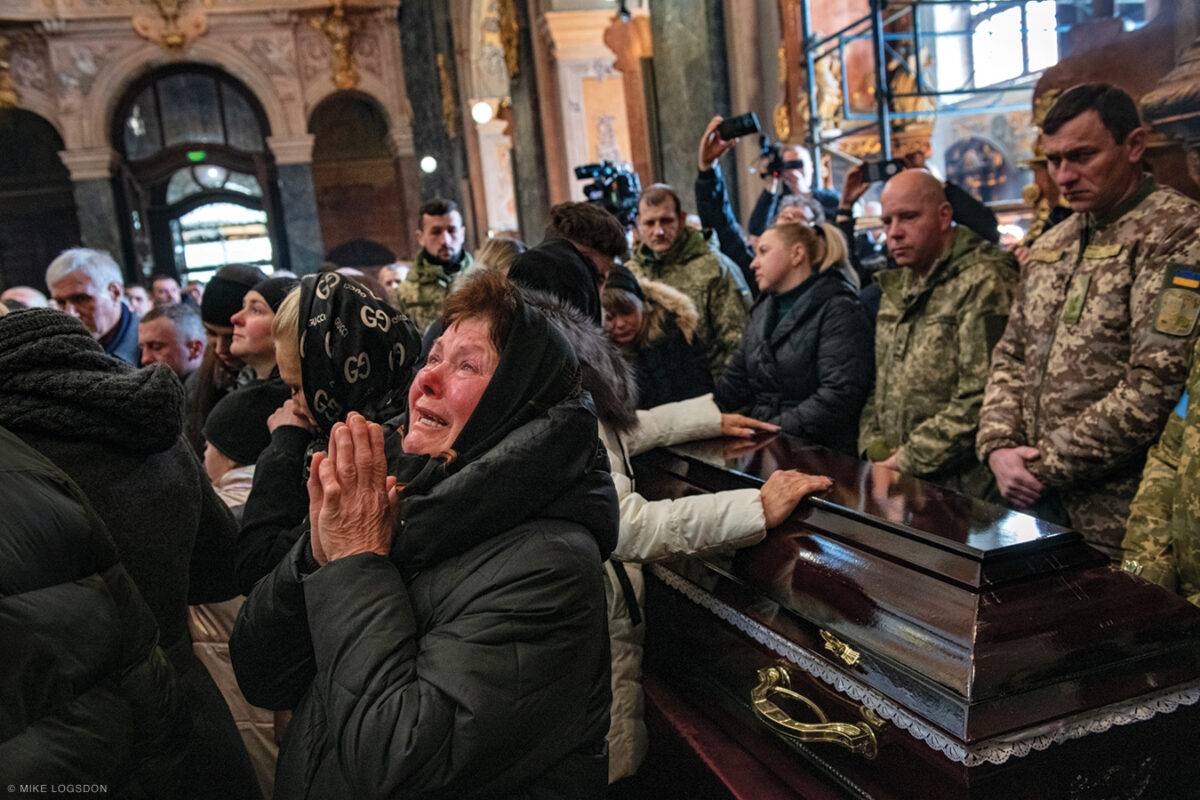
DEMOCRACY, AUTHORITARIANISM, AND CULTURE WAR
Putin’s violent gambit supercharged a line of thinking that had already been gaining ground in the West. “The world has broken up into democratic and autocratic spheres,” as George Packer put it in the Atlantic on February 28. “This division shapes everything from supply chains and competition for resources to state corruption and the influence of technology on human minds and societies.” Russia’s invasion of Ukraine, he posited, “is the most dramatic but far from the last point of conflict between the two spheres.”
Which, again, is one way to look at it.
“Not all autocracies behave the same way,” cautioned Benjamin Nathans. “Even the Russian autocracy’s behavior has fluctuated quite significantly over the last 20 years. So let’s not slip into this pattern of thinking that the world is black and white and we can understand geopolitics simply by considering those two variables.”
As Rudra Sil noted, the Democracy vs. Autocracy framing fails to account for how differently the United States approaches, say, Russia, Venezuela, China, and Saudi Arabia. It can also obscure frictions between autocratic states, even as it glosses over the use of political subversion and state violence by democratic governments. Moral imperatives are rarely the primary driver of geopolitics, and democratic nations are not necessarily reliable guarantors of democracy elsewhere. Indeed, one Western “mistake” Mitchell Orenstein lamented was the Clinton administration’s meddling in Boris Yeltsin’s reelection campaign in 1996.
“He came into that election with a 3 percent popularity rating. People detested Yeltsin,” Orenstein said. Russia’s per capita GDP had fallen fully 25 percent during his tenure, which also saw exploding mortality rates among prime-aged adults, particularly men. “But his challenger was the Communist party leader Gennady Zyuganov, and the Clinton administration put huge resources into teaching Yeltsin political techniques [that] turned that election around. I think that was huge mistake. My view is that democracy would have been better, even if they elected Zyuganov. [Clinton officials] were worried it would have been a reversal, but they got a reversal anyway, in 1999 when Putin got elected. And Putin was way worse than Zyuganov would have been. I think he would have governed more like a social democrat than a Communist. Nobody could have turned Russia back into a Communist state.”
Yet the fact that democratic states sometimes compromise their own stated principles does not change a central characteristic of autocratic leaders: “fear of genuine political competition,” as Nathans put it, “where leaders have to open themselves up to referendum every so many years. That’s something they do not want in their own country, and they’re willing to fight to keep it out.” And Putin, who “watched it happen in Ukraine and in Georgia,” is “spooked that popular unrest and popular mobilization could make its way into Russia.”
Perhaps the biggest potential source of unrest within Russia is also the biggest differentiator between the first and second halves of Putin’s reign: the economy. Between 1999 and 2013, according to World Bank data, Russia’s per capita GDP rose by 1,000 percent—driven substantially by a quintupling of oil prices. But since 2013 (when oil prices entered a six-year slump), the country’s per capita GDP has tumbled by 35 percent.
Even a non-democratic leader needs sources of legitimacy. So in the context of anemic economic growth, Putin has in recent years pivoted to cultural conservatism as a basis for popular support.
“Putin has positioned himself as what he calls a defender of traditional values,” said Nathans. “He has positioned Russia as a bulwark against the kind of ‘liberal, godless, gender-bending, permissive society’ that he sees as having arisen in the US and Western Europe. And there is no mistaking how important sexual orientation, gender identity, and the structure of families is to his politics.”
That rhetoric may also account for the rise in Putin’s popularity among some US Republicans. Putin’s favorability ratings among Republicans rose from 11 to 27 percent between 2015 and 2017, according to Pew Research Center polling, even as Democrats further soured on him. As right-wing pundit Dinesh D’Souza articulated it in a February 24 tweet—echoing Fox News host Tucker Carlson, but after one full day of Russia’s invasion had killed more than 100 combatants and civilians—“Biden Democrats … pose a far greater threat to our freedom and safety than #Putin. He’s the lesser evil. They are the greater one.”
For a subset of American conservatives who fear that the bulk of the US electorate is slipping into a decadent liberal secularism that majority-rule is likelier to exacerbate than reverse, Putin emerged in the late 2010s as an object of some esteem. He “not only speaks up vigorously and emphatically for their idea of traditional values,” Nathans observed, but Putin “represents a model of how a non-democratically-elected official can nonetheless rule effectively and maintain broad popular support.”
Putin appeared to forfeit much of that Western-conservative admiration by invading Ukraine, which prompted widespread revulsion across the US political spectrum. But within Russia, the culture war blended seamlessly into the real one. Kirill, the Patriarch of the Russian Orthodox Church, justified the invasion of Ukraine on the basis of stopping Kyiv’s growing tolerance of Gay Pride parades. This view cast Putin as a civilizational savior—a role to be relished by a man who by many accounts is preoccupied with his historical legacy above all else. The World Russian People’s Council, an organization Kirill heads, explicitly tied culture-war objectives to military ones: “If … we are trying to stop the advancement of NATO, [and] missiles on our borders, then the moral problems associated with the protection of traditional values are aligned, and they are no less important than political and military aspects.”
The Russian populace is by no means monolithic. In the first month of the war, an estimated 200,000 Russian citizens fled their own country as Putin cracked down on civil liberties. “Thousands of Russians have exhibited incredible bravery by protesting,” Nathans added. “Not just in Moscow and St. Petersburg, but lots of places. Unfortunately, Russia is a country of 150 million—and a few thousand street protestors, instantly arrested, is not going to be enough to change Putin’s policies. As much as I admire and support these demonstrators, I see no signs that they’ll have an impact.”
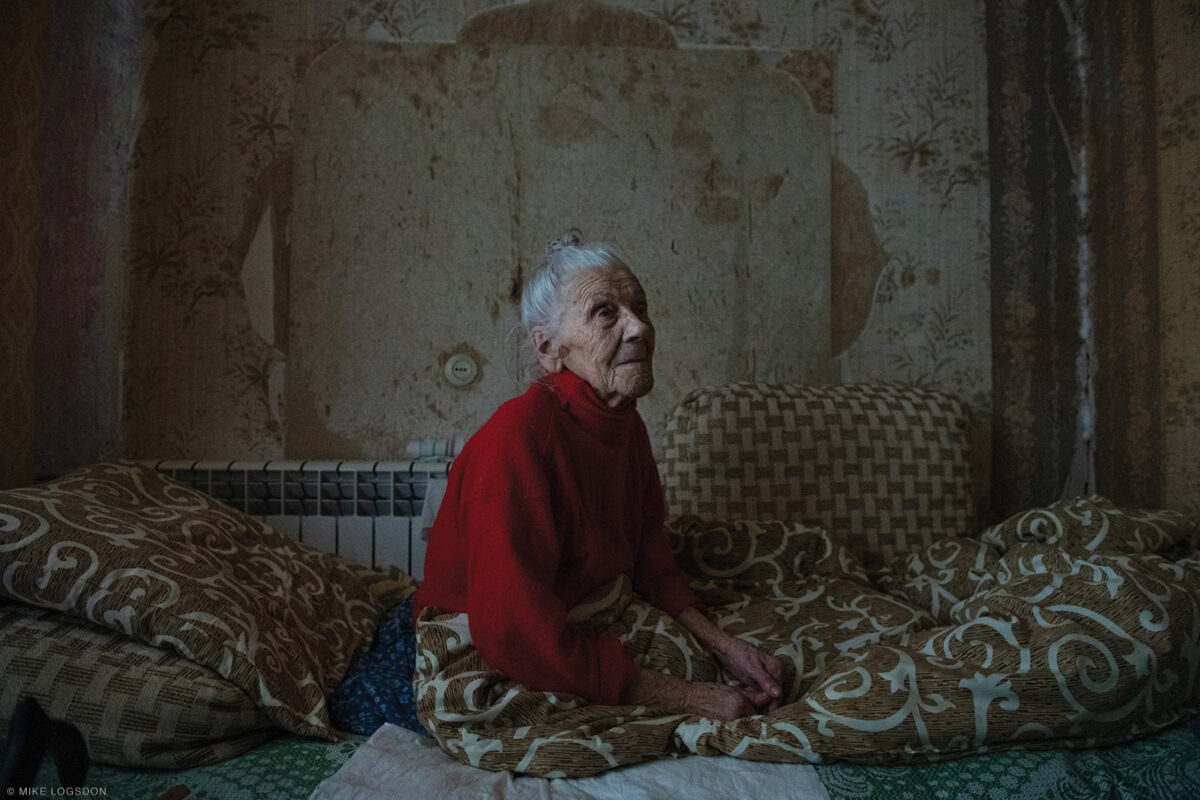
WHAT NEXT?
By all indications, Vladimir Putin expected to get his way in Ukraine in a matter of days. Not having set foot in the country since 2014, “he didn’t understand how nationalistic and pro-EU Ukraine had become,” said Orenstein. Putin’s reported arrest of senior figures in the Russian FSB’s foreign intelligence branch in early March suggested reprisals for a “massive intel failure” that painted Ukrainians as ready to melt in the face of Russian occupation, if not welcome it outright.
Yet as this article was being prepared, the war was entering its second month. The cost has been staggering. As of March 21, the UN High Commissioner for Human Rights had verified nearly 1,000 civilian deaths, including 78 children. Casualty estimates for Ukrainian and Russian soldiers ranged into the tens of thousands. The UN High Commissioner for Refugees estimated that some 10 million Ukrainian citizens—a quarter of the populace—had been displaced from their homes, including 3.5 million who had fled to other countries.
“It’s highly likely that when Putin was planning,” noted Benjamin Nathans, “they understood that it would create a massive outflow of refugees—which would help [the Kremlin] by further destabilizing European countries. But it’s a little different in that the Ukrainian refugees going into Poland are not as foreign as earlier ones from the Middle East. So there’s much more sympathy in host countries.”
The sustainability of that sympathy was one question that loomed over an unpredictable future.
Another involved the economic impacts on Western nations of the sanctions they had imposed, which during the war’s first month were augmented by a remarkable range of voluntary corporate withdrawals from Russia. The case of Germany illustrated the vulnerability of contemporary supply chains to even modest disruptions in trade. Exports to Russia make up 2 percent of Germany’s total, and imports just 1 percent. At the outset of the invasion, Germany’s economic minister estimated the domestic fallout of sanctions at $20 billion, which is just .5 percent of the country’s GDP.
“In relative terms, that seems small,” said Wharton finance professor Stephan Dieckmann. “But what has already happened is supply chains being affected. For some of the car manufacturers, it might be as small as one or two pieces missing in a production line,” but that can halt everything. “On Day One or Day Two, Volkswagen said, We cannot run this anymore—and that’s in their main headquarters in Wolfsburg.”
Similar dynamics were playing out across the EU and US—where different breaking points held the potential to fracture a united front whose longer-term sustainability was open to question.
Rudra Sil speculated that trade disruptions could also threaten Putin’s most important alliance. “The real pivot might come,” he said, “when China says: Enough, this is not helping our attempt to reach Europe in terms of trade routes and the Belt and Road Initiative.” Beijing’s massive BRI infrastructure investments aim to support exports “through Kazakstan, Russia, and Belarus into Poland and into southern Europe. All of that doesn’t work if there’s a wall separting Russia from the rest of Europe. So at some point I think [Chinese President] Xi is going to say, Okay, we gave you a fair amount of support, which enabled you to survive, but now cut some deal, get out of this—we need to be able to move our goods.”
Yet Sil noted that Beijing’s ambition to develop lucrative new trade routes through the melting Arctic Circle—where Russia’s lengthy northern frontier gives Moscow outsize influence—could give Xi countervailing reasons to back Putin in exchange for favorable treatment there.
The invasion sparked a worldwide spike in oil prices that also catalyzed a round of jockeying among fossil fuel interests in the US. Though this took on a predictably partisan cast—as Republicans enacted the time-honored tradition of blaming the party in power for gasoline-price inflation—it reprised arguments that have been advanced by both parties over the years. Or even over the course of a single day, as on March 8, when President Biden and a group of GOP senators separately issued calls for “energy independence.”
“Energy independence has ostensibly been a goal articulated by every president since Richard Nixon,” observed political science professor Robert Vitalis, whose 2020 book Oilcraft: The Myths of Scarcity and Security that Haunt US Energy Policy casts a skeptical eye on the idea.
“I concluded a long time ago, along with many economists, that the notion of energy independence is a fiction,” he said. “It appeals to nationalism and is supported by two kinds of interests: domestic producers of oil and gas, and conservationists, for lack of a better term. But it’s not really possible. In the 21st century, the US—as we can see right now—is not walled off from shocks to a global market. And oil is a global market.”
Behind calls for energy independence, Vitalis sees a grasp for subsidies. Before a compromise between Barack Obama and a GOP-controlled Congress lifted a 40-year ban on oil exports in 2015, for instance, that prohibition was typically justified on the grounds of “energy security or independence,” he noted. “But really all it did was subsidize refiners. If producers can’t sell their oil on the global market, that’s a boon to refiners who have a captive product that can’t be sold to the highest bidder,” effectively boosting their profit margin on ingredients that go into products ranging from plastic bags to antihistamines.
“But there are varieties of subsidies, like the support firms get for projects like the Keystone Pipeline,” Vitalis continued. “What firms are worried about are regulations: controls over their choices of where to invest, how to invest, what to do with profits and so forth. So they were certainly unhappy with the Democratic Party’s talk about a Green New Deal and so forth. They see this as a moment to roll back some of those concerns. But no firm can ever make the argument: We want a subsidy because it increases our bottom line. All subsidies to firms, sectors, or regions have to be couched in terms of national interest. ‘Energy independence’ is that argument in a nutshell, and people respond to it.”
That rationale warrants skepticism, in Vitalis’s view—but no corporate leader or lobbyist worth his salt will be willing to let a crisis go to waste, and the invasion of Ukraine is a mighty one.
Insofar as today’s crisis may shape responses to future ones, the war’s first month also inspired some speculative ideas around campus. Benjamin Nathans provided one that serves as an ending point—both because it arises from unprecedented circumstances and reflects the limited leverage that Ukraine and its Western quasi-allies have over a nuclear-armed Vladimir Putin.
In the wake of their swift decision to freeze Russia’s foreign reserves, “it might not be a bad idea for the Western powers to announce to Russia that all of the costs associated with housing and feeding and protecting refugees from Ukraine—wherever they end up—will be deducted from those frozen accounts.
“This would create an ongoing disincentive to produce more refugees,” he said, suggesting that frozen funds could also be escrowed to rebuild war-torn infrastructure. International law prohibits one country from spending another’s money, he conceded. But there is a precedent: “The Iranian funds frozen by the US after 1979 have been frozen ever since, and the US has begun to pull out a portion for victims of Iranian terrorists.” If Putin’s regime were to be found culpable of war crimes, he suggested, it might open the door to a similar process.
Like everything else about the future of Ukraine and its citizenry, however, that prospect remained unknowable, and grim.


